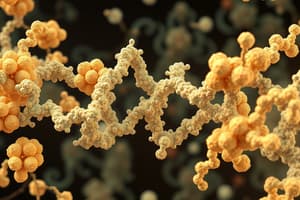Podcast
Questions and Answers
What type of macromolecule is an enzyme?
What type of macromolecule is an enzyme?
protein
What is the function of an enzyme?
What is the function of an enzyme?
To speed up chemical reactions and lower activation energy.
What is a catalyst?
What is a catalyst?
Something that increases the rate of a chemical reaction without itself undergoing any permanent chemical change.
What does it mean to denature an enzyme?
What does it mean to denature an enzyme?
How does an enzyme act on a substrate?
How does an enzyme act on a substrate?
What is the active site?
What is the active site?
Give an example of an enzyme and the substrate it acts on.
Give an example of an enzyme and the substrate it acts on.
What are the two types of reactions that an enzyme is needed for?
What are the two types of reactions that an enzyme is needed for?
What does an enzyme do to the activation energy?
What does an enzyme do to the activation energy?
What are the four things that affect the rate of an enzyme's activity?
What are the four things that affect the rate of an enzyme's activity?
What is the optimum temperature range for human enzymes?
What is the optimum temperature range for human enzymes?
What happens to the reaction rate when you increase the concentration of either the enzyme or the substrate?
What happens to the reaction rate when you increase the concentration of either the enzyme or the substrate?
What is an inhibitor?
What is an inhibitor?
What are the types of inhibitors?
What are the types of inhibitors?
Give an example of a human enzyme.
Give an example of a human enzyme.
Know examples of polymers for each macromolecule.
Know examples of polymers for each macromolecule.
Flashcards are hidden until you start studying
Study Notes
Enzymes and Macromolecules
- Enzymes are classified as proteins, which play a crucial role in biological processes.
- Their main function is to accelerate chemical reactions and decrease the activation energy required for reactions to occur.
- A catalyst increases the rate of a chemical reaction without undergoing any permanent change itself.
- Denaturation of an enzyme involves the alteration of its characteristics due to factors like heat or acidity, resulting in the loss of its active site.
- Enzymes interact with substrates by either breaking apart or forming bonds, facilitating biochemical events.
- The active site of an enzyme is the specific region that binds with a substrate during a reaction.
- An example of an enzyme is nuclease, which acts on nucleic acids as its substrate.
- Enzymes are essential for two primary types of reactions: condensation and hydrolysis.
- By lowering activation energy, enzymes enhance the speed of chemical reactions.
- The reaction rate of enzymes is influenced by four main factors: temperature, pH, enzyme concentration, and substrate concentration.
- The term “optimum” refers to the most favorable conditions for enzyme activity.
- The optimal temperature range for human enzymes is between 35 to 40 degrees Celsius.
- Increasing the concentration of either the enzyme or substrate initially increases the reaction rate until it reaches saturation, after which the rate levels off.
- Inhibitors are substances that hinder or slow down substrate binding to enzymes.
- There are two types of inhibitors: competitive inhibitors, which block the active site directly, and non-competitive inhibitors, which prevent substrate binding indirectly.
- An example of a human enzyme is lactase, which helps digest lactose in dairy products.
Macromolecules
- Carbohydrates can exist as polymers like cellulose, starch, and glycogen, providing energy and structural support.
- Lipids include polymers such as saturated and unsaturated fats, important for storing energy and forming cell membranes.
- Proteins also form polymers, including enzymes, keratin, and hemoglobin, which are critical for numerous biological functions.
- Nucleic acids, essential for genetic information transfer, include polymers such as DNA and RNA.
Studying That Suits You
Use AI to generate personalized quizzes and flashcards to suit your learning preferences.




